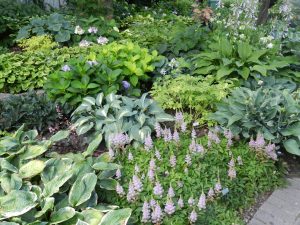
Astilbe chinensis ‘Pumila’, an old but valued standby
Astilbe are a mainstay of the shady garden but they will also thrive in full sun if sufficient water is supplied. Although many of them have already bloomed, there are some cultivars that do not bloom until August. There are many cultivars on the market but I’ve been trialing some of the newer ones, thanks to my friends at DeVroomen.

Astilbe ‘Look at Me’ with Geranium ‘Rozanne’, Geranium sanguineum, and Hemerocallis foliage in south-facing slope.
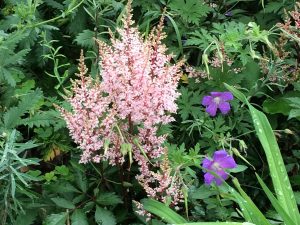
Astilbe ‘Look at Me’ closeup
‘Look at Me’ is a large, fluffy, pale pink inflorescence that resembles cotton candy on a red stick (stem). Bred to be only 15-17” high, it stands out in the landscape, even when nestled behind daylilies and into Geranium ‘Rozanne’. It shows best when planted in a grouping of three or more. In my garden, it is usually in bloom from mid-June to early July. Mine is planted on a south-facing hill that gets morning sun but afternoon shade.
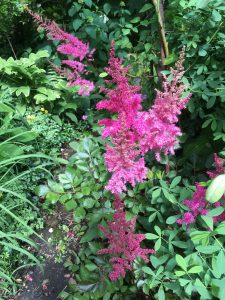
Astilbe ‘Freya’

Color echo of the foliages of Dryopteris erythrosora, Astilbe ‘Freya’
Astilbe ‘Freya’ flowers are hot pink above bronzy-green foliage. Its spiky flower is much narrower than that of ‘Look at Me’ but a bit taller at 20”. It also blooms a week or two later. Although I eagerly await the flowers, I enjoy the bronze foliage in May when it echoes the color of the new fronds of Dryopteris erythrosora (Autumn Fern).
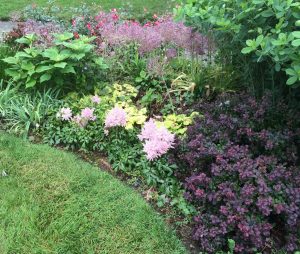
Astilbe ‘Sugarberry’ with Allium christophii and Berberis ‘Concorde’
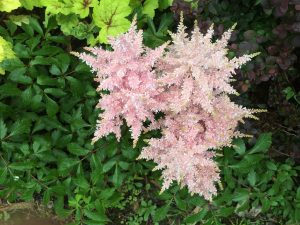
Astilbe ‘Sugarberry’ closeup
Astilbe ‘Sugarberry’, a member of the Short and Sweet series, is the shortest of the cultivars I want to mention. Only 10” tall but 14” wide, its plumes are a bit unusual, being a spiky, triangular shape. The pale pink plumes bloom in mid-June and definitely benefit from being shaded so the sun doesn’t bleach the color. Mine are planted at the top of a south-facing hill but are shaded by the foliage of Hibiscus ‘Pinot Noir’ and the large heads of Allium christophii. Nearby is Berberis ‘Concorde’, a sterile purple barberry, the color of which complements that of this Astilbe.
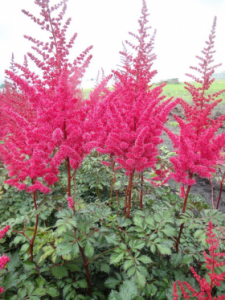
Astilbe ‘Mighty Red Quin’ closeup – – thanks to Uncle John’s Plant Farm for photo
Astilbe ‘Mighty Red Quin’ is a chinensis hybrid meaning that it blooms even later than the aforementioned cultivars. The foliage emerges bronze and ages to dark green, topped in mid-summer with 4′ tall, bushy spikes of cherry red flowers. Mine have struggled but only because I have planted them in a less than ideal situation – too dry but the survivors are spectacular because of both color and height.
Many of the cultivars I have mentioned have chinensis heritage. I tend to plant these more often than the arendsii because they are more drought tolerant, bloom later – usually mid-July – and are rhizomatous rather than clumping, thus working better as a slow-moving groundcover. You probably have some Astilbe in your garden but now is a good time to see if you need more to fill some empty spaces. Regardless of which one you use, happily, they are all deer and rabbit resistant.


1 Comment